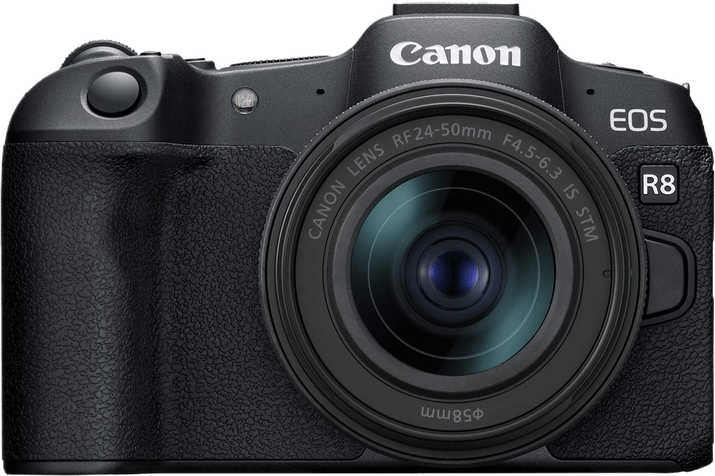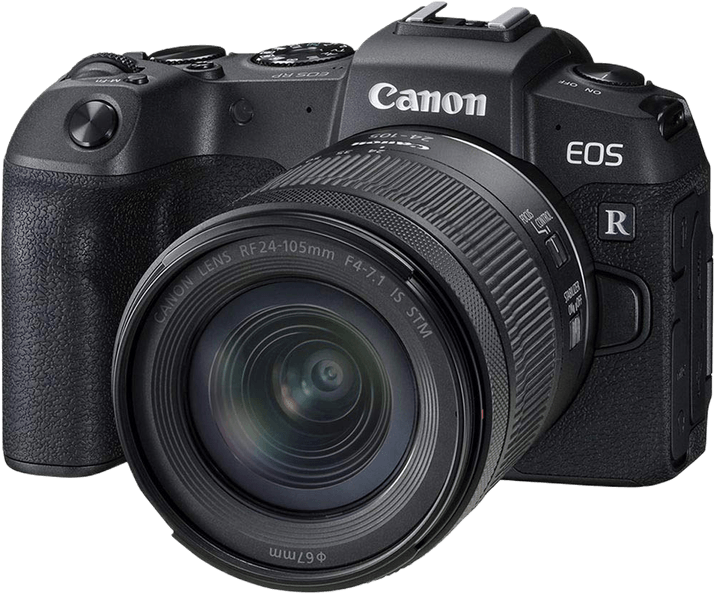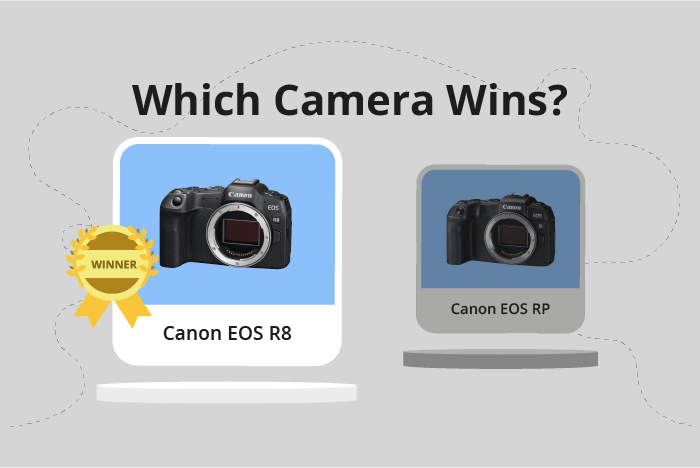Canon EOS R8 vs EOS RP Comparison
Canon EOS R8

Canon EOS RP

The Canon EOS R8 outperforms the Canon EOS RP with a score of 76/100 compared to 65/100. Both cameras are mirrorless and share similar dimensions, with the EOS R8 measuring 133 x 86 x 70mm and the EOS RP at 133 x 85 x 70mm. They also have a slight difference in weight, with the EOS R8 weighing 461g and the EOS RP at 440g.
The EOS R8’s higher score reflects its superior performance and features. Launched in 2023 with a price of $1499, it offers advanced technology and improved capabilities compared to the EOS RP, which was released in 2019 and priced at $1300.
However, the EOS RP does have its advantages, such as its lower price and slightly lighter weight. This makes it a more budget-friendly and portable option for some users.
Taking these factors into account, the Canon EOS R8 is the better choice for those seeking a higher-performing camera with more advanced features. On the other hand, the Canon EOS RP is a suitable option for those prioritizing affordability and portability.
Canon EOS R8 vs EOS RP Overview and Optics
The Canon EOS R8 outperforms the Canon EOS RP in optics, scoring 77/100 compared to the RP’s 67/100. Both cameras share several features, including a CMOS sensor, full-frame sensor size, Canon RF lens mount, and the absence of image stabilisation. However, the R8 excels in certain areas, making it the superior choice in terms of optics.
The R8 has a shooting speed of 40, significantly faster than the RP’s 5, which enables the R8 to capture fast-moving subjects with ease. Additionally, the R8 is equipped with a more powerful processor, the Digic X, compared to the RP’s Digic 8. This results in better image processing and overall performance. Furthermore, the R8 boasts a higher DXOMARK score for its sensor at 94, compared to the RP’s 85, indicating better image quality and low-light performance.
On the other hand, the RP has a slight advantage in megapixels, with 26 compared to the R8’s 24. This allows the RP to capture slightly more detail in images. However, this advantage is minimal and does not outweigh the other areas where the R8 excels.
Taking all these factors into account, the Canon EOS R8 is the clear winner in optics. Its superior shooting speed, powerful processor, and higher DXOMARK score make it the better choice for photographers seeking optimal image quality and performance. While the RP has a slight edge in megapixels, it falls short in other crucial areas, and thus it cannot compete with the R8’s overall optical capabilities.
Canon EOS R8 vs EOS RP Video Performance
The Canon EOS R8 outperforms the Canon EOS RP in video capabilities with a score of 91/100, while the RP scores 70/100. Both cameras share some common specifications, including a maximum video resolution of 4K and dimensions of 3840 x 2160. They also both have built-in time-lapse functionality.
The R8 excels in its maximum video frame rate, offering 180fps, which is significantly higher than the RP’s 25fps. This higher frame rate enables the R8 to capture smoother and more detailed slow-motion footage. The R8’s video performance is superior to the RP’s due to this key difference.
On the other hand, the RP may still be a suitable option for those who do not require high frame rates for their video projects. Its 4K resolution and time-lapse functionality are shared features with the R8, allowing for quality video capture in certain situations. However, the RP’s lower video score indicates that its overall video performance lags behind the R8.
Considering the differences in video capabilities, the Canon EOS R8 is the clear winner for those seeking a camera with high-quality video performance and slow-motion capabilities. The RP, while still offering 4K resolution and time-lapse functionality, falls short in comparison due to its lower frame rate. Ultimately, the choice between these two cameras depends on the specific video requirements of the user. The R8 is the superior option for those prioritizing video performance, while the RP may be sufficient for users with less demanding video needs.
Canon EOS R8 vs EOS RP Features and Benefits
The Canon EOS R8 outperforms the Canon EOS RP in features, scoring 85/100 compared to the RP’s 70/100. Both cameras share several specifications, including a 3-inch touchscreen, flip screen, GPS absence, WiFi, and Bluetooth connectivity.
The R8’s superiority lies in its screen resolution, which boasts 1,620,000 dots compared to the RP’s 1,040,000 dots. This higher resolution provides sharper and clearer image previews, enhancing the user experience and aiding in accurate focus and exposure adjustments. The R8’s 21-point advantage in the feature score highlights its overall better performance and user experience.
While the EOS RP falls short in screen resolution, it is still a capable camera with a solid feature set. Its shared specifications with the R8, such as the 3-inch touchscreen, flip screen, WiFi, and Bluetooth, ensure a reliable and user-friendly experience. Despite its lower feature score, the RP remains a viable option for photographers who prioritize these shared features.
In comparing the two cameras, the Canon EOS R8 stands out as the better option due to its higher screen resolution and overall superior feature score. However, the Canon EOS RP should not be disregarded, as it offers many of the same essential features as the R8. Ultimately, photographers must consider their specific needs and preferences when choosing between these two capable cameras.
Canon EOS R8 vs EOS RP Storage and Battery
The Canon EOS R8 outperforms the Canon EOS RP in storage and battery with a score of 35/100 compared to the RP’s 29/100. Both cameras possess one memory card slot and support SD, SDHC, and SDXC memory cards. The EOS R8 is UHS-I and II compatible, while the EOS RP is UHS-II compatible.
The EOS R8’s advantage lies in its battery life, providing 370 shots compared to the EOS RP’s 250 shots. Both cameras use the same LP-E17 battery type and offer USB charging. The longer battery life of the EOS R8 ensures more shooting time for photographers.
The EOS RP, however, has an edge in memory card compatibility, supporting faster UHS-II cards, which can potentially enhance performance in certain situations.
Considering the storage and battery aspects, the Canon EOS R8 proves to be the superior choice due to its extended battery life, while the Canon EOS RP offers slightly better memory card compatibility.
Canon EOS R8 vs EOS RP – Our Verdict
Are you still undecided about which camera is right for you? Have a look at these popular comparisons that feature the Canon EOS R8 or the Canon EOS RP:

